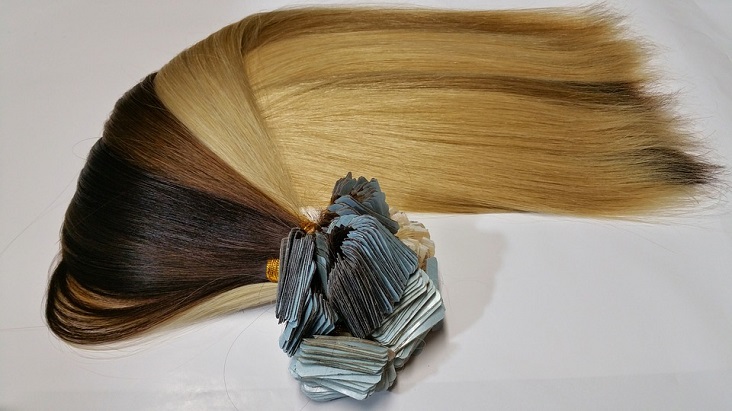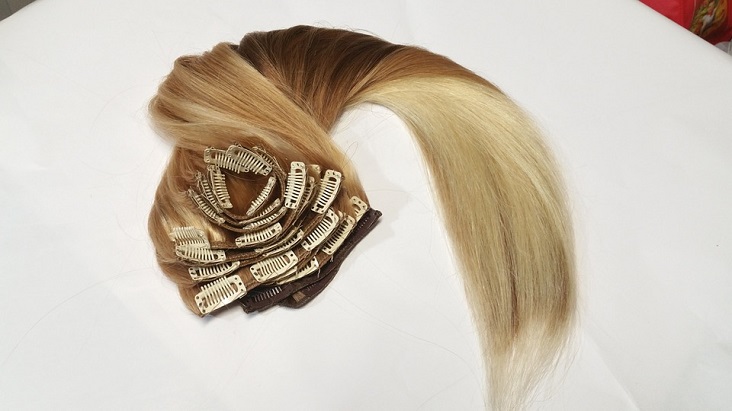Who hasn’t at some point, watched a hair care advert with envy, wishing that you had gorgeous long, thick locks like the deliriously happy model. You could flick it over your shoulder and whip your hair back and forth to your heart’s content. Unfortunately, long beautiful hair like that doesn’t come easy. It takes forever to grow, and may of us couldn’t ever grow hair like that, no matter how much we willed it.

That is why hair extensions are such an attractive option. Within a short space of time your look is completely transformed. But, as tempting as they are, they definitely should not be a rash decision, so we have put together a little guide to the pros and cons of the different types of hair extensions.
Clip In Hair Extensions
These are the hair extensions that clip into your natural hair, through clips that are sewn onto the weft of the extension. They usually range in width for different areas of the head, from one clip for the area in front of the ear, to three or four clips for the back of the head.
Pros of Clip Ins
- Gives the wearer lots of versatility as they can be put in or taken out on a daily basis.
- There is no commitment, so color and length can be changed whenever you like.
- They are very easy to put in and take out, with no need to go to a salon.
- Compared to other extension methods, it is relatively affordable.
- Will cause minimal or no damage to hair.
Cons of Clip Ins
- Although real hair versions are available, clip in extensions are usually made from poorer quality synthetic hair.
- They can’t be worn for long periods of time and need to be removed before sleeping.
- As the clips are somewhat bulky, they may not be suitable for thin hair. And do not work well for up dos.
- They can fall out or shift over the day.
- Without proper care, they will only last for a few months.

Fusion Hair Extensions
Come in to a salon for hot or cold fusion methods. For hot fusion, keratin U-tip bonds lined with silicone on small sections of hair, are bonded close to the root of natural hair with heat. For the cold fusion method, small sections of hair, held together in copper cylinders are pulled through a lock, which is clamped shut with a special tool. The silicone lining acts as a protection barrier to protect natural hair.
Pros of Hot Fusion
- With good maintenance they are one of the most permanent hair extensions, lasting up to 6 months.
- Suitable for most hair types, including thick and coarse hair.
- A discrete hair extension that blends with natural hair.
- Most often made with good quality real human hair.
Cons of Hot Fusion
- Has one of the longest application times, with the norm being around 6-8 hours.
- If you don’t go to an experienced hair technician with lots of experience, there may be damage and breakage when applying.
- The heat used to apply the extension can damage hair.
- The hair extensions are not reusable, which makes them expensive compared to other methods.
- There may be discomfort in the days following application, such as itchiness, or a tight pulling sensation.

Pros of Cold Fusion
- The hair extensions move naturally.
- No glue or heat is used for application and they can still last between 6-12 months.
- The hair extensions are reusable, if one drops out, the same one can be reapplied.
- Good quality human hair is usually used.
Cons of Cold Fusion
- Like its hot fusion counterpart, it is a very timely method, taking around 4-6 hours.
- The locks may be visible if they have not been applied properly, and they are not really suitable for thin hair as the bond will show through.
- The bonds are not as secure as with heat fusion and they may slip.
- As the micro-links/locks are made with metal, they can heat up through styling (i.e.drying with a hair dryer) and damage the natural hair.
- Discomfort may be experienced in the first few days following application.
Weave Extensions
Small sections of natural hair are braided as a base for the extensions, with wefts of hair sewn into them with a needle and thread.
Pros of the Weave
- The extensions are very secure and will not slip unless a braid comes loose.
- No glue or heat is needed for application, therefore causing minimal damage to the hair.
- Suitable for thick and coarse hair, and they look natural on most hair types.
- One of the more affordable hair extension methods.
Cons of the Weave
- Fairly timely application, taking a number of hours.
- Those with thin hair need to be careful as if the weft is too heavy it can pull harshly on natural hair.
- If the supporting braid is too tight, it can cause pain in the scalp and headaches, as well as scabbing and even hair loss.
- If the hair is not washed regularly, there may be a build up in bacteria, possibly causing infection.
- Not as versatile in terms of styling options.

Tape In Extensions
Tape In extensions are a relatively new method of hair extensions, which are applied with a polyurethane tape, either double-sided or single sided, depending on the thickness of natural hair.
Pros of Tape In
- Very quick application time taking between 30-60 minutes.
- No heat or glue is required for application, with minimal damage to natural hair.
- The extensions lie flat against the head, so they are almost undetectable, even in thin hair.
- The weight of the weft is distributed over a larger area, so they don’t pull on natural hair, meaning there is minimal breakage of natural hair.
- The hair extensions are reusable, making them cost effective.
- With proper care they can last between 6-8 weeks.
Cons of Tape In
- As the tape needs time to bond properly, hair cannot really be washed within the first 48 hours.
- Oil based styling products or shampoos cannot be used as they may cause the taped panels to slip.
So, now you know the pros and cons of the main types of hair extensions, and you can make an informed decision. Be sure to have a consultation with your stylist at your salon, as they will be able to tell you which hair extensions will be best for you and our hair type. Until your appointment for hair extensions, keep your natural locks looking their best with this 3 ingredient hair mask for dry or damaged tresses!





